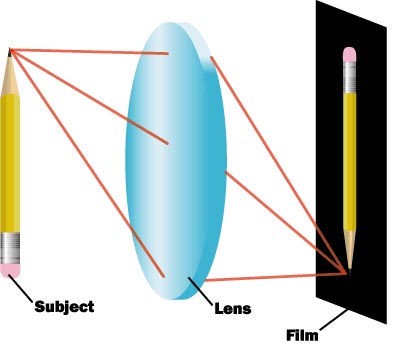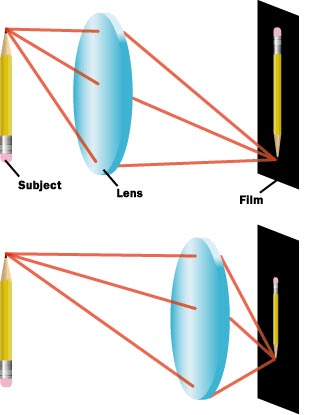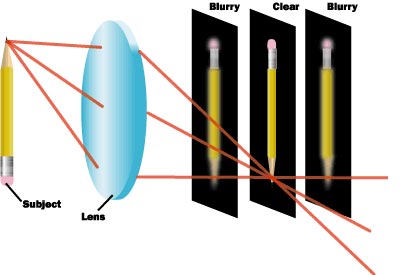At its simplest, a lens is just a curved piece of glass or plastic. Its job is to take the beams of light bouncing off of an object and redirect them so they come together to form a real image -- an image that looks just like the scene in front of the lens.
But how can a piece of glass do this? The process is actually very simple. As light travels from one medium to another, it changes speed. Light travels more quickly through air than it does through glass, so a lens slows it down.
When light waves enter a piece of glass at an angle, one part of the wave will reach the glass before another and so will start slowing down first. This is something like pushing a shopping cart from pavement to grass, at an angle. The right wheel hits the grass first and so slows down while the left wheel is still on the pavement. Because the left wheel is briefly moving more quickly than the right wheel, the shopping cart turns to the right as it moves onto the grass.
The effect on light is the same -- as it enters the glass at an angle, it bends in one direction. It bends again when it exits the glass because parts of the light wave enter the air and speed up before other parts of the wave. In a standard converging, or convex lens, one or both sides of the glass curves out. This means rays of light passing through will bend toward the center of the lens on entry. In a double convex lens, such as a magnifying glass, the light will bend when it exits as well as when it enters.

This effectively reverses the path of light from an object. A light source -- say a candle -- emits light in all directions. The rays of light all start at the same point -- the candle's flame -- and then are constantly diverging. A converging lens takes those rays and redirects them so they are all converging back to one point. At the point where the rays converge, you get a real image of the candle.
Focus
A real image is
formed by light moving through a convex lens. The nature
of this real image varies depending on how the light
travels through the lens. This light path depends on two
major factors:
-
The angle of the light beam's entry into the lens
-
The structure of the lens
The angle of light entry changes when you move the object closer or farther away from the lens. You can see this in the diagram below. The light beams from the pencil point enter the lens at a sharper angle when the pencil is closer to the lens and a more obtuse angle when the pencil is farther away. But overall, the lens only bends the light beam to a certain total degree, no matter how it enters. Consequently, light beams that enter at a sharper angle will exit at a more obtuse angle, and vice versa. The total "bending angle" at any particular point on the lens remains constant.

As you can see, light beams from a closer point converge farther away from the lens than light beams from a point that's farther away. In other words, the real image of a closer object forms farther away from the lens than the real image from a more distant object.
You can observe this phenomenon with a simple experiment. Light a candle in the dark, and hold a magnifying glass between it and the wall. You will see an upside down image of the candle on the wall. If the real image of the candle does not fall directly on the wall, it will appear somewhat blurry. The light beams from a particular point don't quite converge at this point. To focus the image, move the magnifying glass closer or farther away from the candle.

